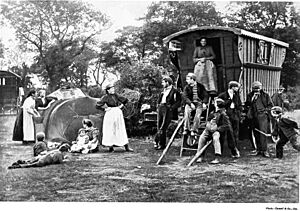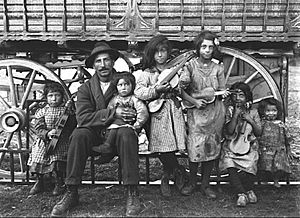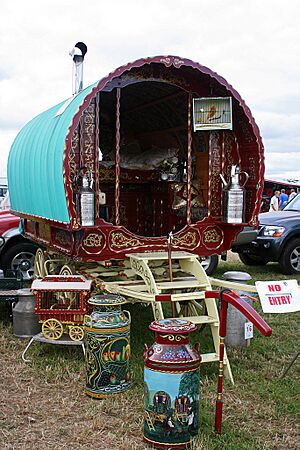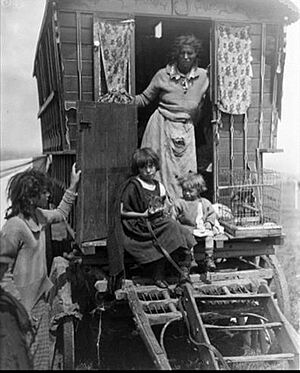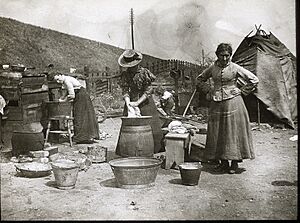Romanichal facts for kids

A Gypsy Girl by George Elgar Hicks (1899)
|
|
| Regions with significant populations | |
|---|---|
| No reliable numbers; UK census data gives fewer than 58,000, though this may be unreliable | |
| 164,000 (estimate) | |
| 14,000 (estimate) | |
| 6,600 (estimate) | |
| 3,900 (estimate) | |
| 1,500 (estimate) | |
| Languages | |
| English and Angloromani | |
| Religion | |
| Majority: Christianity Minority: Romani mythology, irreligion |
|
| Related ethnic groups | |
| English, other Roma especially Welsh Kale, Scottish Lowland Travellers, Romanisæls, Finnish Kale, Sinti, and Manouches |
|
The Romanichal (also known as English Gypsies) are a group of Romani people. They mostly live in the United Kingdom and other English-speaking countries. Many Romanichal speak Angloromani, which is a special language. It mixes words from the Romani language with English grammar. Romanichal in England, Scotland, and Wales are part of the wider Gypsy, Roma, and Traveller community. Studies show that Romani people originally came from Northern India.
Contents
Understanding the Name "Romanichal"
The name "Romanichal" comes from the words Romani chal. In the Angloromani language, chal means "fellow" or "person".
Where Romanichal People Live
Most Romanichal in Great Britain live in England. Smaller groups can be found in South Wales, Northeast Wales, and the Scottish Borders.
Many Romanichal families have moved from Great Britain to other English-speaking countries. Some people believe there are now more Romanichal in the United States than in Britain.
In Great Britain, Romanichal communities are divided into two main areas. Southern Romanichal live in places like the Southeast, Southwest, and Midlands. Northern Romanichal live in the Northwest, Yorkshire, and Scottish Borders. These two groups have different accents and words in their language.
The Angloromani Language
Romani people in England likely spoke the Romani language until the 1800s. After that, English and Angloromani became more common. Angloromani is a creole language. This means it combines the sentence structure of English with words from the Romani language.
Today, most Romanichal speak both English and Angloromani. Only a small number are thought to still speak the traditional Romani language.
Angloromani has two main forms: Southern Angloromani and Northern Angloromani. These forms are spoken in different parts of the UK. They have led to two different Romanichal identities. Many Angloromani words have even become part of everyday English slang.
A Look at Romanichal History
The Romani people began their journey from the Indian subcontinent around the 11th century. They traveled through Western Asia and the Balkans. This journey took them through places like Armenia and Turkey. They eventually reached countries like Bulgaria, Serbia, and Romania.
Because of wars, especially during the Ottoman rule, they kept moving. They traveled further north and west into Europe.
Records show Romani people arrived in England in 1512. They had traveled from Spain to Scotland first.
During the time of King Henry VIII, a law called the Egyptians Act 1530 was made. It said Romani people could not enter England. Those already there had to leave quickly. If they did not, they could lose their property or be sent away. Later, under Queen Mary I, the law changed. It offered Romani people a chance to stay if they stopped their nomadic life. But if they did not, the punishment became even harsher.
In 1562, a new law allowed Romani people born in England and Wales to become English subjects. However, they still faced unfair treatment. They were often forced to live on the edges of society. In 1596, many Romani people were sentenced to death in York.
Laws against Romani people slowly ended from the 1780s. The Romanichal group formed between 1660 and 1800. They became a distinct Romani group living in Britain.
Facing Unfair Treatment
Unfair treatment and dislike against Romani people still exist in the UK. In 2008, a study showed that Romani people faced more racism than other groups. A poll also found that many UK residents admitted to having negative feelings towards Romani people.
Being Sent Away
Authorities started sending Romanichal people away as early as 1544. They were often sent to places like Norway. Queens Elizabeth I and James I continued this practice.
The Finnish Kale, a Romani group in Finland, believe their ancestors came from Scotland. This supports the idea that they are related to Scottish Romani and English Romanichal.
In 1603, an official order was made to send Romanichal to other countries. These included the Low Countries, France, Newfoundland, Spain, and the West Indies. Many of those sent away lost touch with their families. They were separated during the journey and when they settled. Some were even forced into slavery. At the same time, some Romanichal chose to move to English lands overseas. Romani groups who survived continued their culture in these new places.
After the American War of Independence, Australia became a common place to send Romanichal prisoners. The exact number sent to Australia is not known. Some believe three Romanichal were on the First Fleet. One was James Squire, who started Australia's first brewery. His grandson later became a leader in New South Wales.
It is thought that Romanichal people were treated very harshly under these laws. Being sent away meant losing their family and culture.
Romanichal Culture and Traditions

Romanichal are part of the larger Romani people community. They celebrate important events like International Romani Day. This day remembers the first World Roma Congress held in London in 1971. Romanichal in the United Kingdom have their own unique culture. They call non-Romani people Gorjas or "country people."
Key parts of Romanichal culture include:
- Strong focus on family and extended family.
- Following traditional roles for men and women.
- Special customs for births and deaths.
- Great importance on cleanliness in their homes.
- Respect for older family members. They often call older community members "aunts" and "uncles."
- A history of traveling (though many now live in houses).
Romanichal customs have been shaped by the idea of marimé or mochadi. This means ritual impurity, guiding what is considered clean or unclean.
Most Romanichal in the UK are Christian. Their religion is a big part of their culture and celebrations. In the 2021 census, over 70% of Romani people in England and Wales said they were Christian.
Historically, Romanichal people worked in farming. They would move to the edges of towns in winter. In spring, summer, and autumn, they found work on farms. This included planting, weeding, and harvesting crops. The hop industry was very important. Thousands of Romanichal worked in hop fields. In winter, they did odd jobs in towns or sold goods door-to-door.
Today, traditional jobs include gardening, fortune telling, and collecting scrap metal. Some Romanichal have also become famous boxers or footballers. When farming became more industrial in the 1960s, many of these traditional jobs disappeared.
The word Didicoy is sometimes used for a person with both Romani and non-Romani family. However, this word can be seen as offensive.
Romanichal Travel and Homes
In the past, Romanichal traveled on foot or with horse-drawn carts. They would build bender tents when they stopped. A bender is a tent made from bent hazel branches covered with canvas.
Around the mid-1800s, Romanichal started using wagons with living spaces inside. They called these "vardos." Vardos were often brightly painted and decorated. Today, most Romanichal live in houses or caravans.
More than 60% of Romanichal families now live in houses. The other 40% live in mobile homes like caravans or trailers. A very small number still live in vardos.
In 2008, there were over 13,000 caravans owned by Romani people in the West Midlands of England. Another 16,000 lived in houses. Most traveling Romanichal live on official sites where they pay taxes.
On most Romanichal traveler sites, caravans usually do not have toilets or showers inside. This is because in Romanichal culture, these are considered unclean or mochadi. Most sites have separate buildings with toilets and showers. Many Romanichal also prefer to do laundry outside. In the past, women would wash clothes in a river. They were careful to wash different types of clothes in separate areas of the river.
A law from 1968, the Caravan Sites Act 1968, made it harder to find legal places to park caravans. This means many Romanichal cannot find sites to live with their families.
Like other traveling groups, Romanichal who are not settled travel for work. They often follow old routes and stopping places. These places, called atching tans, have been used for hundreds of years. Many were set up long ago when Romani people provided farm work in exchange for a place to stay.
Today, most Romanichal travel in the same areas their families have used for generations. Many families can trace their history in an area back hundreds of years. While some traditional stopping places are now owned by local governments, Romanichal travelers have strong ties to them. Most families are known by their winter home base. This is where they stop traveling for the colder months.



